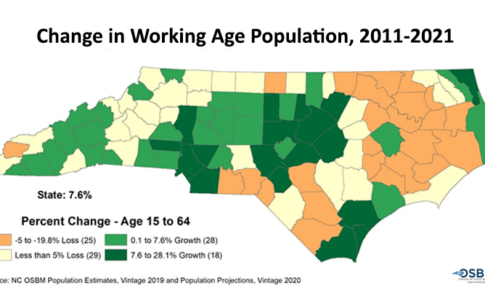Where Are the Workers? Changes in Working Age Population Influences Labor Market

Dr. Michael Cline is the state demographer for North Carolina at the Office of State Budget and Management and has given us permission to re-post his content here. Each year, he publishes population estimates and projections for North Carolina and its counties.
April marked the second month in a row that the Bureau of Labor Statistics reported a record number of open jobs. A recent study by the National Federation of Independent Businessesfound that nearly half of small businesses in the U.S. have unfilled job openings, with most of those hiring managers saying they aren’t getting qualified applicants. While the struggle to fill jobs as the economy recovers from the pandemic may seem like a recent phenomenon, employers were having difficulty finding workers before the pandemic too.
While not the only factor, North Carolina’s changing population contributes to this challenging labor market. Growth in our working age population (ages 15 to 64) continues, but at rates much lower than in years past. Between 2016 and 2020, North Carolina’s working age population increased by an average of 55,303 per year (0.8%). This was half of what we experienced ten years prior, when we added 111,094 working age people annually between 2006 and 2010. Our rural counties have experienced an even greater challenge as growth in these working ages has been a third of the growth of ten years ago (after declines following the Great Recession).

Part of the reason the working age population has grown more slowly is the simple fact that there are many more people aging out of this age group than in years past. In 2011, the first Baby Boomers (those born between 1946 and 1964) became 65, the traditional age of retirement. Today, in North Carolina, more than half of this cohort is at least 65 years old. Will there be enough people to replace these retiring Baby Boomers?
One way to look at this is to simply compare those at the beginning of their employment life relative to those at the end. Interestingly, in 2000, for every North Carolinian age 60 to 64, there were 1.8 North Carolinians ages 20 to 24. By 2011, there were only 1.2 people in the younger ages for every one person at the oldest. That has since declined to 1.1 people in 2021.
In our rural counties, since 2011, there have been just as many people entering prime working ages as there are moving towards retirement ages. While urban and regional city/suburban counties have also seen a precipitous drop in this ratio, there are still more people entering prime working ages than leaving. According to our latest population projections, these ratios will remain for the foreseeable future as more Baby Boomers turn 65.

Of course, trends summarized for urban, regional center/suburban, and rural counties obscure differences within those categories. Not every rural county has experienced loss in the working age population including many western counties like Jackson (5.3%), Macon (3.7%), and Polk (3.1%). Similarly, not every non-rural county has experienced population gains (Cumberland had a 5.1% loss in the working age population). Between 2011 and 2021, the working age population in the majority (54 of 100 counties) shrunk. Of these, 25 – mostly in eastern North Carolina – lost more than 5% of this age group. At the same time, in 46 counties the working age population grew – with 18 counties experiencing growth rates larger than the state’s.

As our population continues to age, we will experience slower rates of growth (and in some areas, decline) in our prime working age population. This will mean that finding enough workers will remain challenging.
This short analyses of the working age population used our 2020 Vintage population projections for North Carolina and all 100 counties. These population projections are available to visualize online or to download for use in other applications. For the first time, our projections provide a longer look at our future – extending beyond the 20 years we typically prepare. These datasets include age, sex, race, and Hispanic origin characteristics and regional/county type identifiers, including urban/rural county, Councils of Governments planning areas, and Metropolitan Statistical Areas.
Need help understanding population change and its impacts on your community or business? Carolina Demography offers demographic research tailored to your needs.
Contact us today for a free initial consultation.
Contact UsCategories: Carolina Demographics, Economic Data

The Center for Women’s Health Research (CWHR) at the University of North Carolina School of Medicine released the 12th edition of our North Carolina Women’s Health Report Card on May 9, 2022. This document is a progress report on the…

Dr. Krista Perreira is a health economist who studies disparities in health, education, and economic well-being. In collaboration with the Urban Institute, she recently co-led a study funded by the Kate B. Reynolds Foundation to study barriers to access to…

Our material helped the NC Local News Lab Fund better understand and then prioritize their funding to better serve existing and future grant recipients in North Carolina. The North Carolina Local News Lab Fund was established in 2017 to strengthen…
Your support is critical to our mission of measuring, understanding, and predicting population change and its impact. Donate to Carolina Demography today.